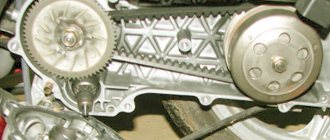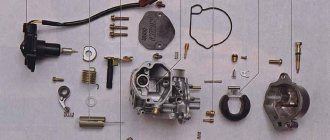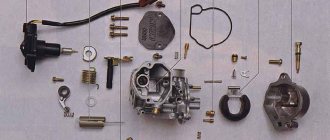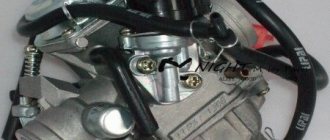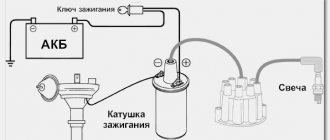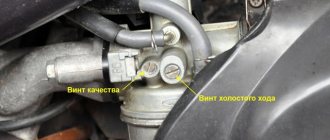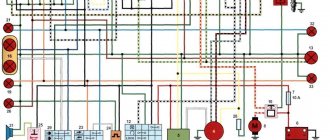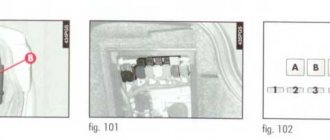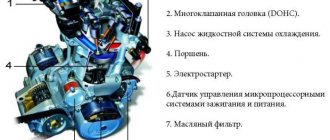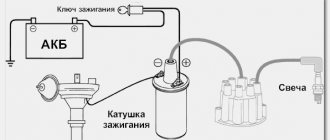Scooter engine - device Scooter carburetor - device, setup Scooter crankshaft Scooter gearbox - device Scooter clutch - device, setup Scooter variator - device Scooter chain drive device Scooter electrics Scooter brake system Switch - electronic ignition of the scooter Scooter speed limiters
Radius run
A more correct formulation for the technical characteristics of the scooter transmission would be the following: “automatic continuously variable.” In fact, we are talking about such a type of transmission as a V-belt variator , which appeared quite a long time ago, but due to its characteristics, it received the greatest development on scooters, as well as on snowmobiles.
The design of such a transmission is much simpler than a classic manual gearbox, and even more so than the notorious “automatic machines” that cars are equipped with (by the way, some representatives of the four-wheeled world also have a CVT, but a different one than on scooters). It is very simple to understand how a variator works if you remember the system for changing gear ratios on bicycles: several sprockets in front, several in the back, and they are connected by a chain.
True, the V-belt variator does not have any sprockets, but there are two V-shaped pulleys, consisting of two cone-shaped halves. These halves, called cheeks, can move closer to or further away from each other. The pulleys are connected by a flexible variator belt, which has the cross-sectional shape of an isosceles trapezoid. Depending on the position of the pulley cheeks relative to each other, the belt in the variator pulley can be either closer to the pulley axis (inside) or closer to the outer edge of the pulley (outside). The closer the belt is to the pulley axis, the smaller the radius along which the belt runs, or, as they say, the working radius of the variator pulley. Now let's imagine a system of two pulleys and a belt in action. If the “working radii” of each pulley are the same, then when one rotates, the other will rotate at exactly the same speed. If we rotate a pulley whose working radius is larger, then the other one (whose radius is smaller) will rotate faster. Here it’s time to remember “bicycle sprockets” again; it’s just that in a variator, a larger sprocket corresponds to a larger working radius of the pulley, and a smaller sprocket corresponds to a smaller radius.
Design and characteristics of a scooter's variator
The variator is one of the most important components of a scooter. It is a mechanical continuously variable transmission. This is both a complex and simple knot. The task of the variator is to replace a large and inconvenient gearbox. Thanks to this part, the design of the scooter has been greatly simplified, and it has become easier for the driver to control it. Not the last task of the variator is to transmit torque to the wheel with maximum efficiency. In appearance, this is a rather simple mechanism, but in order to set it up you will need maximum attention and skill. To set it up correctly, you need to remember the following factors: the weight and size of the rollers, the diameter of the pulleys, their amplitude, the length and width of the belt, the stiffness of the torque driver spring, the stiffness of the clutch springs, and so on.
There are many types of different variators, but in scooters, as a rule, V-belt ones are installed, of which there are in turn two: auto-V-belt and mechanical.
The design of a V-belt variator is as follows: two sliding pulleys and a V-belt connecting them. The two conical surfaces that form the pulley are called “cheeks,” and there is a certain gap between them. The pulley that is rotated by the engine is called the drive pulley, and the one from which the power is taken is called the driven pulley. The drive pulley is attached to the left journal of the crankshaft, and the driven pulley is connected to the rear wheel gearbox through the clutch mechanism. When the crankshaft speed changes, the variator clutch changes the distance between the pulley cheeks.
V-belt variator
The V-belt variator consists of: 1 - fixed cheek of the drive pulley, 2 - V-belt, 3 - movable cheek of the drive pulley, 4 - plate with guide weights, 5 - weights, 6 - fixed cheek of the driven pulley, 7 - movable cheek of the driven pulley, 8 — spring, 9 — centrifugal clutch. Due to the fact that scooters are equipped with V-belt variators, they are quite easy to operate even for people who have never driven a motorcycle.
A scooter's variator can be classified as a mechanical transmission type. To put it in plain language, the variator is capable of providing the optimal transmission ratio at a certain point in time. Inexpensive scooters are equipped with mechanical variators; their operation is carried out by rollers. This solution did not work well. Friction and temperature have a negative effect. Expensive branded models are equipped with CVTs, which are controlled by an on-board computer. In order to maximize the capabilities of a standard mechanical type variator, install rollers that need to be selected according to weight, or it is better to buy a ready-made set and thus the power of the scooter will increase and it will work more smoothly.
The variator is closely related to the operation of the clutch. If one thing does not work correctly, it will affect the work of the other.
There are several parameters by which you can determine the correct operation of the variator and by which you can judge its good tuning. First, the belt should not slip in the pulleys. Slippage should be minimal. Otherwise, it can damage the transmission and parts will wear out much faster. How can you determine that slippage is occurring? You will see that your scooter is "roaring, trying to go, but it is not succeeding." Slippage can also be caused by excessive wear. Second, the engine speed must be constant. Even at the factory, the scooter’s variator is adjusted optimally using special weights. Some experimenters change them to lighter ones in order to increase acceleration, but this should not be done, otherwise you can lose not only the acceleration speed, but also the maximum speed in general. The factory setting of the variator is considered ideal, and changing it is not recommended; it can only worsen the situation. The most optimal setting allows you to ensure smooth acceleration without any failures and, most importantly, in the desired speed zone.
Variations on the handle
So, with the general principles of changing the gear ratio everything should be clear, now it’s time to proceed to the mechanism of this change, that is, how to make the scooter’s variator pulleys move and move apart exactly when required. To do this, let’s immediately make a reservation that in a scooter variator it is customary to highlight the leading
pulley (located on the crankshaft) and
driven
(located on the clutch shaft). In the bowels of the drive pulley there are special cylindrical weights (sometimes also called rollers). These plastic-coated metal bushings are placed in special grooves in which they can move radially. If you move the weights in the drive pulley from the center outward, they will inevitably move the pulley cheeks together. In fact, of course, only one cheek of the variator pulley moves, but this is not important. When the pulley rotates, the weights, under the influence of centrifugal force, tend outward and, shifting the pulley cheeks, push the belt outward. The faster the pulley rotates, the stronger the centrifugal force acting on the weights, and the further outward the compressing pulley cheeks will push the belt. The driven pulley has no weights, but has a large spring that constantly tries to squeeze its jaws together and push the belt out. Like the driving pulley, the driven one has only one moving part - the external one (referred to in foreign literature as the torque driver). It is the torque driver that moves either outward, overcoming the resistance of the spring and allowing the belt to “fall” inside the pulley, or, conversely, inward, closer to the fixed part of the pulley. Thus, the change in the working radii of the scooter's variator pulleys always occurs synchronously. When the belt goes out in the driving pulley, then in the driven pulley, overcoming the resistance of the spring, the belt, on the contrary, moves inward, closer to the axis of the variator pulley.
For a more complete understanding of the process, let’s see how the scooter’s variator behaves under different engine operating modes.
At idle, the rotation speed of the variator drive pulley is minimal. Although a certain centrifugal force acts on the weights, it is not enough to pull the belt out. After all, this requires overcoming the resistance of the large spring of the driven pulley! But now the gas is open, the crankshaft speed jumps, and now the centrifugal force acting on the weights is already enough to push the variator belt in the drive pulley a little outward. Drive pulley coupling: cover; guide plate; coupling body; rollers.
The gear ratio changes. The rotation speed of the driven pulley of the variator increases significantly, which forces the centrifugal clutch to operate. The scooter starts moving. The engine speed reaches its operating level, meanwhile the belt continues to move further and further outward in the drive pulley of the variator, and deeper in the driven pulley. That is, the speed remains unchanged, but the gear ratio gradually changes, making the scooter go faster and faster. This, by the way, hides one of the great advantages of the variator - acceleration occurs at constant speeds, so you can configure the entire system so that during acceleration the engine will operate at its maximum power (for example, this is impossible to achieve with a manual transmission). Finally, the belt reaches its maximum design radius in the drive pulley of the variator, and its minimum in the driven pulley. However, as a rule, it is possible to accelerate a little faster, but by increasing the speed of the scooter's engine, and not by increasing the transmission.
When the throttle is closed while driving, the engine brakes the scooter for some time until the centrifugal clutch disengages. As soon as it is turned off, under the action of the large spring of the driven pulley, the belt returns to its original position, as when idling a scooter. But as a rule, the scooter’s clutch disengages only when it comes to an almost complete stop (10 - 25 km/h).
By the way, about the scooter’s clutch. This device, although it performs independent functions, is very closely connected with the scooter’s variator : if the clutch does not work correctly, the variator will not work correctly, and vice versa. A scooter's centrifugal clutch is almost always three drum-type brake pads that are pushed outward by centrifugal force and engage the clutch drum. The clutch assembly itself is mounted on the driven pulley of the variator and rotates, but the clutch drum is on a shaft, which transmits torque to the rear wheel through a simple gearbox. Thus, in order to make the scooter move, you need to make the clutch drum rotate. This happens as soon as the driven pulley of the scooter's variator gains sufficient rotation speed so that the centrifugal force becomes large enough for the pads to overcome the elastic force of the clutch springs, which prevents their free movement outward. These same springs will “disengage” the clutch, squeezing the pads together when the rotation speed of the driven pulley drops below the critical level for the clutch to operate. As you can see, the system is simple. And it works almost flawlessly, reducing control of the power unit to twisting the throttle (hence, by the way, the name of one popular scooter magazine: Twist'n'go - “Twist and Ride!”). Which not least determined the current wave of popularity of scooters.
This video shows the CVT in action. Shown in the best possible way.
The design and principle of operation of a scooter variator
What is a variator? A variator is a mechanical continuously variable transmission. It is used to smoothly change the rotation speed of the driven shaft. Basically, all types of scooters have a V-belt variator. It consists of a drive pulley, a driven and a V-belt and works only depending on the number of engine revolutions, without reacting to loads (for example, when going uphill, the load on the rear wheel increases, but the gear ratio remains unchanged), which is one of its disadvantages .
Let's start with the simplest. Why V-belt? From the picture on the left you can see that the belt in section has a trapezoidal shape and is “wedged” into the pulley only with its side surfaces. When these surfaces wear, due to their shape, it cuts deeper into the pulley and still remains in good adhesion to it.
How does the gear ratio change? The design of the drive pulley (the drive pulley is rotated by the crankshaft) is such that its cheeks, when exposed to centrifugal forces, smoothly compress and push the V-belt further and further from the center of the pulley. The driven pulley, on the contrary, unclenches, and the belt on it smoothly sinks closer and closer to the center of the pulley. The higher the engine speed, the more the drive pulley compresses and the driven pulley expands, thereby changing the gear ratio from the crankshaft to the rear wheel. This process is clearly visible in these figures:
The engine is not running.
Low engine speed.
Average engine speed.
Maximum engine speed.
The figures also show the positions of the V-belt in a section on the drive pulley (left) and driven pulley (right) under different engine operating modes.
How is the drive centrifugal pulley of the variator arranged? Quite simple! Let's look at its design, shown in the figure:
Drive centrifugal pulley of the variator.
1 - fixed pulley cheek, rigidly screwed to the trunnion (tail) of the crankshaft 5 with a bolt 8 with washer 6. V-belt 2 is placed between cheeks 1 and 3. Cheek 3 is designed so that it moves freely on shaft 5. It is moved by rollers 4 that rest into the persistent and stationary cheek 9. Under the influence of centrifugal force, the rollers 4 diverge from the center of the shaft 5, thereby moving the cheek 3 closer to the cheek 1 and pushing the belt 2 further from the shaft 5. The positions of the rollers 4 and cheeks 3 at different engine speeds you already seen in the four pictures above.
Now a little about the driven pulley (picture below).
Driven pulley.
It differs from the drive pulley in that it does not have rollers, but instead a spring (see picture on the right). At the moment when the cheeks on the driving pulley come together, pushing out the belt, on the driven pulley the cheeks (namely, the cheek 5 moves along the shaft 7, the cheek 6 is installed rigidly and motionless), on the contrary, they diverge, compressing the spring 3, and the belt drops deeper, which again, it can be seen in the engine operating modes above in four figures. Thanks to spring 3, the V-belt is always tensioned, and its tension increases proportionally with increasing speed. This in turn allows the belt to not slip at higher speeds, at which the load is greater than at lower speeds.
There are also simpler models of scooters that do not have a variator on the drive shaft. Instead, a simple pulley is installed and the gear ratio from it to the driven one is fixed at all engine speeds. Such models exceed 50 km/h. do not develop and “stupidly” gain momentum from a standstill. Their driven pulley is the same as that of CVTs - under a spring and serves only to tension the belt. The only advantage of this device is that the belt lasts longer.
Then the automatic clutch, which is assembled with the driven pulley, comes into operation.
Good luck!
Source www.moto.com.ua
